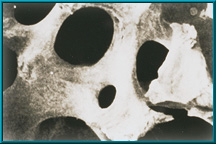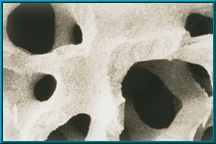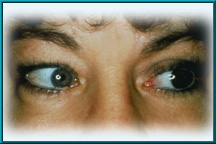Hydroxyapatite (HA)
Hydroxyapatite: the natural choice
The goal of a more natural appearance was finally achieved with the help of a natural material: ocean coral. A remarkable similarity was noticed between the porous structure of certain coral species and that of human bone.
Soon after this discovery, a method was developed to transform the mineral in coral to match that of human bone, known as hydroxyapatite (abbreviated HA).
This naturally derived material has both the porous structure and the chemical structure of bone (Figs. 2 and 3).
-

- Figure 2. Human Bone (magnified)
-

- Figure 3. Hydroxyapatite (magnified)
Thus, the tissues of the body will accept–even grow into–these naturally derived hydroxyapatite implants, and essentially become a “living” part of the body.
The first hydroxyapatite orbital implant
The first orbital implant made of hydroxyapatite was implanted in 1985, after several years of preliminary research.
The eye muscles can be attached directly to this implant, allowing it to move within the orbit-just like the natural eye.

Figure 4. Natural movement with the Bio-eye orbital implant
Some of this movement is automatically transferred to the artificial eye, which fits over the implant. If greater movement is desired, then a peg is used to connect the artificial eye to the implant. In this way, even the small, darting movements of the natural eye can be delivered directly to the artificial eye. The result is a more natural-looking artificial eye that can be difficult to distinguish from the natural eye (Fig. 4).
Next
The Bio-eye® Hydroxyapatite (HA) Orbital Implant

